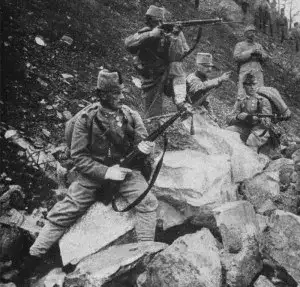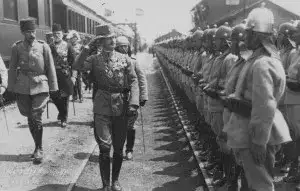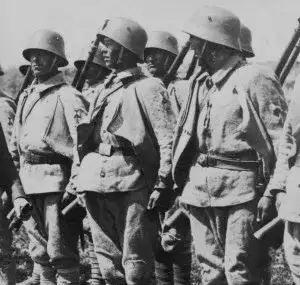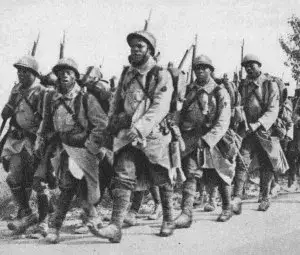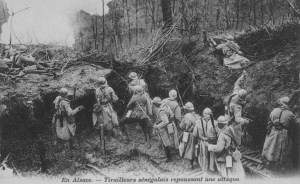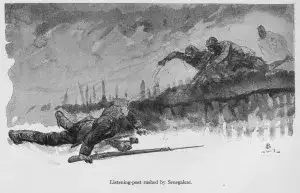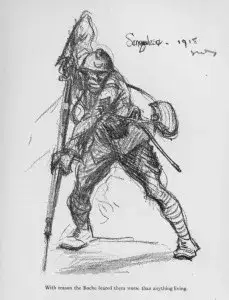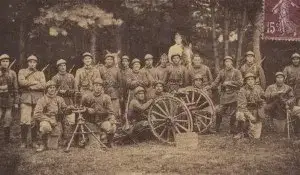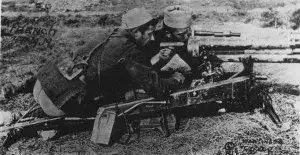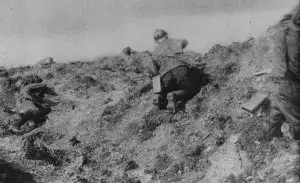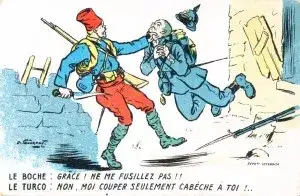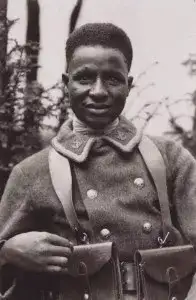The best soldiers of World War I were Muslim
January 14, 2024 by Thomas Wictor
Since we’re talking about France and Muslims, and since we’re now in the centennial of World War I, here’s a post on the best troops of that conflict. Without question, the most skilled, feared, and successful units of both sides were Muslim.
First, the Central Powers—Germany, Austria-Hungary, the Ottoman Empire, and Bulgaria.
The Bosnian regiments of the Austro-Hungarian Imperial and Royal Army were men who never lost a fight.
Note their white gloves, symbols of their elite status. They’re also armed with short carbines rather than rifles so that they can engage in close-quarters trench fighting. Bosnians were famous for their skill with daggers. The saddest book I ever read is titled Isonzo: The Forgotten Sacrifice of the Great War, by John R. Schindler. Although a brilliant work, it’s utterly heartbreaking in its descriptions of futile bloodbaths.
The Italian front was the only battle space in which the opposing sides actually hated each other, due to ancient tribal, religious, and ethnic enmities. They also had the bad luck of being commanded by buffoons who refused to accept the lethality of modern weapons. On the Italian front, men continued to carry out mass charges against machine guns long after the rest of the combatants learned that this was suicidal. Soldiers fought with rocks and even their teeth.
A German flamethrower pioneer who served on the Italian front called it the “Clown Apocalypse.”
But wherever the “Bosniaks” were sent, they prevailed.
The Ottoman Turks had several elite units, including the Istanbul Fire Brigade, shown here at Philipopel in 1918, being reviewed by Austro-Hungarian Emperor Charles I.
Although firefighters, the men were also the best infantry regiment in the Ottoman army. They may also have been equipped with flamethrowers, according to the caption on the back of this photo.
The Turks also had Protection Companies assigned to battalion, regimental, and divisional headquarters.
These men are equipped with steel helmets and bags of hand grenades. They were trained in German shock-troop tactics and were equal to the best of the Allied elite forces.
And now the Allies (France, Great Britain and her dominions, Russia, Italy, Belgium, the United States, Serbia, Greece, Romania, Portugal, Japan, China).
Most of the truly effective Muslim combat units were in the French army. At the top of the list were the Senegalese Tirailleurs (Skirmishers).
These men wear unidentified specialist badges on their upper left sleeves. They most likely have to do with close-quarters combat. The Senegalese were issued machetes called coup-coups, which translates to “hit-hit.”
You can see the machetes on the belts and in the hands of these men.
Although proficient in the art of modern warfare, most Senegalese were from rural areas and had never seen cars, two-story buildings, the ocean, bicycles, and so on. They excelled at night raids. Captain John W. Thomason Jr, United States Marine Corps, fought beside them and illustrated them in his book Fix Bayonets!
Entire German trench sections surrendered without a fight when the Senegalese attacked.
In July of 1918, the French army formed the 1st Moroccan Infantry Division by combining two Moroccan regiments with a battalion of Madagascan light infantry, a regiment of the French Foreign Legion, and the Russian Legion.
The 1st Moroccan Infantry Division received special training in assault tactics. As a “shock division,” it was given the best equipment and sent in first.
Here are Moroccan trench-mortar and trench-gun crews.
Mortars are indirect-fire weapons, meaning you don’t aim at a target. Instead, an observer tells you where the target is, and you figure out where to drop the shell. It comes down in an arc. A trench gun was a small cannon, a direct-fire weapon used as a sniper’s rifle.
This Moroccan trench-gun crew is armed with a cannon removed from its wheeled chassis.
The gun was fitted with a scope, and it fired high-explosive, shrapnel, or armor-piercing shells. It was used to take out machine-gun nests, bunkers, and infantry guns—small cannons that the Germans dragged forward to support an attack. The trench gun was usually fired from a trench, but it was often dismantled and carried along with the first wave of assault troops.
Moroccan soldiers also specialized in hand-grenade throwing.
They would crawl as close as they could to the enemy position, armed only with daggers and bags of grenades. Using sign language, they would silently coordinate until the squad was ready; then they would shower the enemy with dozens of grenades, cleaning out entire trench sections that could then be occupied by assault troops.
The ferocious reputation of French Muslim troops was a source of national pride.
“Mercy!” says the German soldier. “Don’t shoot me!”
“No,” says the colonial soldier. “I’ll just cut off your head!”
It’s clear to me that most Muslim and non-Muslim French citizens are completely ignorant of their history. Because I support Israel, I get tons of messages accusing me of “hating Muslims.” Not one of the people who thinks I hate Muslims has heard of the 1st Moroccan Infantry Division or the Senegalese Tirailleurs.
They were deadly. Each platoon swept its front like a hunting pack, moving swiftly and surely together. The [U.S. Marine] lieutenant felt a thrill of professional admiration as he went with them.
The hidden guns that fired on them were located with uncanny skill; they worked their automatic rifles forward on each flank until the doomed emplacement was under a scissors fire; then they took up the matter with the bayonet, and slew with lion-like leaps and lunges and a shrill barbaric yapping… [T]he skill of their rifle grenadiers and automatic-rifle men always carried them to close quarters without too great loss.
—Captain John W. Thomason Jr., USMC
Fix Bayonets!
I know their stories, and I honor them, knowing full well that they’re Muslims. What would those men think of the world today, a world in which cartoons are seen as a reason to murder? They braved artillery, machine guns, hand grenades, mortar shells, poison gas, and flamethrowers.
How would they view the jihadist terrorists who excel only at killing the defenseless?
This article viewed 5680 times.

